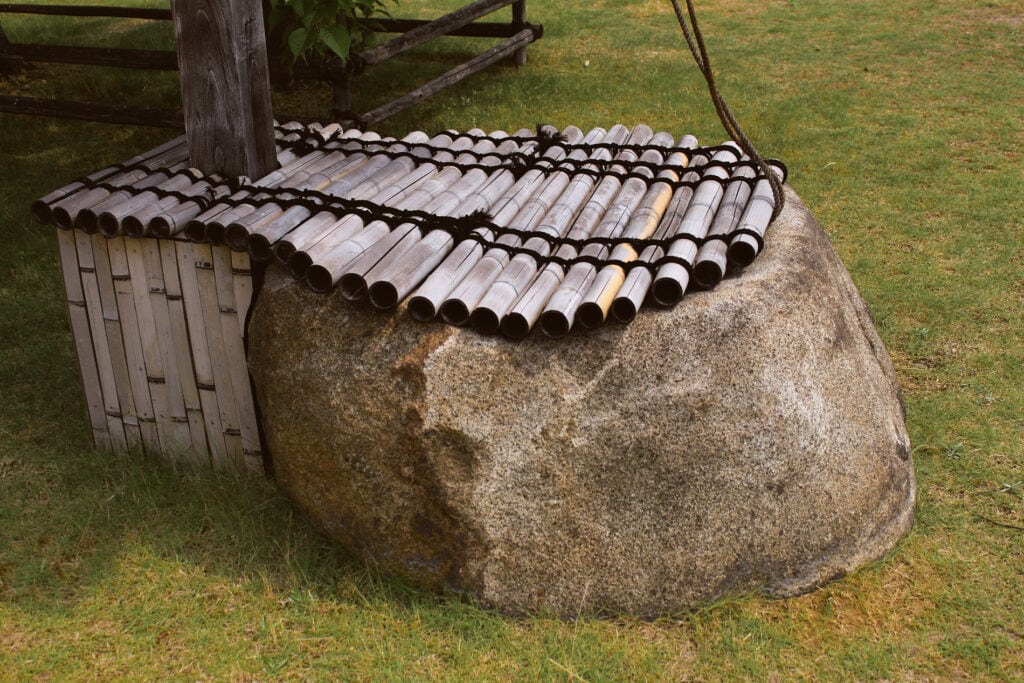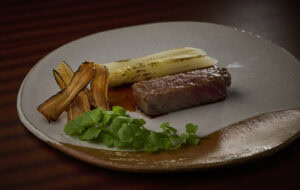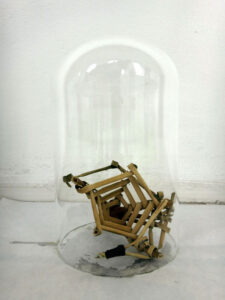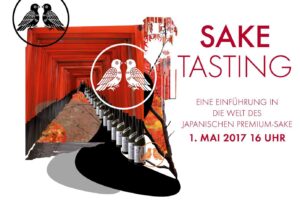Although Japan is an island nation surrounded by water, water is not taken for granted in Japanese culture.
Sake in its commercial form, after all, consists of about 80% pure water.
Multiple use of water in the sake making process
Before rice is even turned into sake, it is exposed to significant amounts of water at each step of the brewing process: The rice is washed, rinsed and soaked before it can be steamed.
Water is then added to the fermenting moromi (醪, main mash in the main fermentation process) in the tanks to each of the (typically) three shikomi (仕込み) or additions of rice, water and Kōji.
Finally, you almost always end up using some water to lower the alcohol content from about 20% to about 16%.
In total, the amount of water that goes into a bottle of sake is more than 30 times the weight of the rice used. Therefore, this topic also deserves at least as much attention.
About the water comes the regionality in the sake
There is no general Appellation system for sake. Therefore, it is not required by law that all ingredients come from the same prefecture where the sake is produced.
However, for practical reasons, sake water is mainly sourced from local wells. Sake brewers highly value the stability of well water for achieving qualitative continuity in sake brewing. Therefore, when siting a sake brewer, an excellent water source is a critical factor.
What qualities need water for sake production?
Water is the ingredient used in the production of sake in the largest quantity.
It is important not only in the fermentation phase, but also in the final phase when water is added to adjust the alcohol content.
Water for a good sake must not only be fresh and clean, but it also needs very specific properties.
The basic requirement for "sake-suitable water" is above all a low iron content (<10%) and a pH value that is as neutral as possible. The better regions for brewing sake in Japan have water with less than 0.02 mg/l iron and manganese. On the other hand, magnesium, calcium, phosphates and potassium are beneficial to sake production and are valued because they support yeast and Kōji.
Which water is suitable or unsuitable for sake production?
There are some indispensable elements without which certain steps of the brewing process cannot run smoothly. And there are some ingredients that are disadvantageous in sake production, because they either hinder the process or otherwise adversely affect the sake (taste).
The "Bad Guys" - elements that should be less in good sake water.
The most harmful of the elements in the water for sake production is Iron.
Iron darkens the color of sake and affects its taste and aroma. This happens because it chemically binds to the center of a normally colorless compound and couples to an amino acid formed during the production of the Kōji mushroom.
As the sake ages, the remaining sugars react with the amino acids present and change its taste and odor. The presence of iron accelerates this reaction.
Manganese plays another problematic role.
When sake is exposed to light, especially ultraviolet light, manganese promotes a chemical reaction that changes or discolors the appearance of a sake.
In direct sunlight, this discoloration is visible in less than three hours.
Although there are other "bad" elements, manganese and iron are the two main culprits in water that prevent its suitability for sake brewing.
The "Good Guys" - Elements in the water that are conducive to good sake.
Then there are the good guys: Elements and compounds in water that are relied upon in the Sake making cannot be dispensed with.
In particular Potassium, Magnesium and Phosphoric acid are necessary in order to Fermentation of the yeast in the "Shubo" (yeast starter) as well as to support the proper development of a good "Kōji". If these elements are not present in sufficient quantities, the yeast cells do not multiply as well or as quickly. As a result, the timing of the entire fermentation is shifted and it cannot be properly controlled in the brewing process.
One of the problems here is that potassium is water soluble, and can be washed away during the rice washing and soaking process. Phosphoric acid presents similar difficulties, as it is generally bound to fat and protein molecules.
It must be removed from them, and the bonds are broken by enzymes. This shows how closely the various aspects of the brewing process are intertwined.
In summary, potassium, magnesium and phosphoric acid strengthen yeast propagation and also support Kōji development. Iron and manganese, on the other hand, negatively affect the taste, aroma and color of a sake in a relatively short time.
Influence of water hardness on Japanese sake
As in Germany, Japan distinguishes between hard (kōsui) and soft water (nansui).
Hard water results in a strong fermentation that produces a clean, strong sake.
Soft water creates a sake that tastes round, smooth and soft.
Water hardness is defined by the amount of minerals in the water, mainly calcium (Ca), magnesium (Mg) and bicarbonate (HCO₃).
Japan generally has very soft water that contains few minerals. The national average is 61 mg HCO₃ per liter (equivalent to about 2.5˚dH.)
The map below shows the average values for each prefecture.
Comparison of water hardness of known sake regions with Europe
Compared to Japan, Germany - and especially our Munich site - has rather hard water.
Thus the Water hardness in Munich 15.8°dH on average. By comparison, tap water in Copenhagen, Denmark, is very hard at 18-24˚dH. Vienna and Zurich both have moderately soft water between 6-11˚dH, while Paris' water is also relatively hard at 14-17˚dH. (Values may vary because cities get their water from different sources).
However, popular European mineral waters such as Evian, Vittel or Contrex reach even higher values of over 80˚dH.
Japanese water is very soft compared to Europe
So water that is considered "soft" in Europe is still much harder than most water in Japan. This is mainly due to geological differences: Europe has a lot of limestone, which adds calcium to the water, while Japan's rocks are mostly volcanic in origin, which don't add much minerals to the water. The large amount of precipitation also contributes to softer water overall.
Sake brewers refer to hard and soft water as either "strong" or "weak water," as hard water promotes faster and more vigorous fermentation, while softer water causes slower fermentation.
Sake water and geographical / controlled designation of origin
Recently, it has become possible to apply for a Protected Designation of Origin (similar to the European DOCG/IGP system), for Japan from Nadagogō (in Hyōgo Prefecture), Yamagata Prefecture or Hakusan (in Ishikawa Prefecture).
The rules specify that the water must be obtained in the area of the respective area, the rice used for the production of sake but can originate from anywhere in Japan.
The water used and its characteristics are therefore ultimately more decisive for the regional character of a sake than any other ingredient!
Therefore, many breweries emphasize how special and unique their water is for making the best quality sake.
Those brewers who are not blessed with a suitable natural source may use ordinary (filtered and purified) water. They may add the necessary amounts of minerals and nutrients (for example, potassium ions) to obtain a water that suits their brewing style and sake type.
In particular, the water used for the yeast starter (Shubo or Moto) can be treated in this way to ensure good fermentation.
So while water plays an important role in shaping the character of a sake, and even becomes something like the perception of Terroir the ultimate character of the sake also depends largely on the decisions and skill of the brewmaster (Tōji).
Some Tōji produce sake with a specific profile using a technology-driven process. This then meets a specific demand or the very personal ideas of the brewers.
Other brewmasters tend to work with the raw materials their region has to offer, even if that limits them to a certain flavor expression.
Some breweries actively use water as a "tool" and use different water sources for different sake qualities.
Monten, brewed in Usui Shōten in Nagano Prefecture, is one such example: the Purple Label Junmai Ginjō is brewed with hard water from a spring under the northern Japanese Alps and has a distinctive and crisp taste, while the rest of the sake in their product range uses soft water from Iyari National Park.
If you ever get the chance to taste a sake and the water it was brewed with side by side, you should take it!
It is always an interesting experience and you can try to find common taste characteristics in both.
By the way: Yamagata Prefecture was one of the first regions to receive GI certification (see also under Dewa 33).
Characteristics of various water sources and sake regions in Japan
Where can you find the best water for sake? In Japan, of course! In fact, Japan offers a variety of regional sources whose characteristics greatly affect the sake produced. Here is a journey through some of the most important sources in Japan.
Nada (Kōbe/Hyōgo Prefecture) and the famous heavenly water
Nishinomiya (西宮市), the place where Hakushika sake has been brewed since 1662, is known for one of the best waters in Japan. The very valuable and "hard" water, called "Miyamizu", is the most famous example of "strong water", which is 8˚dH. The water is rich in potassium (20 mg / l) and phosphate (5.2 mg / l), which accelerates fermentation and produces full-bodied sake.
Chemical and geological analyses have clarified the composition of Miyamizu water. It feeds from three sources: Miyamizu (宮水), which is the abbreviation for "Nishinomiya no Mizu," is formed by mineral-rich water flowing from the Rokko Mountains and mixing with groundwater from the Shukugawa River and seawater from Nishinomiya Bay. The water passes through a layer of fossil shells. When it then comes to the surface, it is rich in phosphates, potassium and carbonates. Three elements that are important for sake yeast culture to thrive well and quickly.
It has just the right amount of sodium and only small traces of iron, the mineral best avoided in sake brewing. The iron mixes with the acids in the river water. It oxidizes and is then filtered out through the fossil shell layer.
Finally, since the kanji for "Miya" (宮) has the meaning of a shrine or a place where a god resides, the water is also readily referred to as "heavenly water" in some places.
About one-third of all sake in Japan comes from Nada, primarily from large breweries known for producing large quantities of affordable sake.
Fushimi - the fragrant water from the ancient imperial city of Kyōto
The water from Niigata, one of the most famous sake regions in Japan
In parts of Niigata commonly referred to as "Yukiguni," or "snow country," more than 30 meters of new snow falls each year. This abundance of snow melts into pristine water, ideal for creating the light, delicate style of Niigata sake.
It is also believed that the constant snowfall helps to purify the air and rid it of impurities that could negatively affect sake production.
Niigata currently has 96 active sake producers, many of whom export all over the world.
Yamagata
Surrounded by magnificent mountain ranges (Zaō Mountains, Mt. Chōkai and Dewa Sanzan, the sacred 3 mountains of Sanzan with Haguro-san (羽黒山), Gassan(月山, "Moon Mountain") and Yudono-san(湯殿山) ) and home to 100 onsen (hot springs), the water in Yamagata is known for its minerals. Many believe that these minerals impart healing properties to the hot springs. They also result in rich and textured sake when brewed.
Hiroshima (Saijō)
Saijō in Hiroshima Prefecture - where sake is brewed primarily in the Ginō style - was included in the list of famous sake regions because of its particularly good water. The soft water of this area favors slow fermentation, which is necessary for the development of the fruity Ginjō flavors.
However, Hiroshima's exceptionally soft water can also lead to special challenges: Because Hiroshima's water contains so few minerals, yeast and Kōji take a long time to activate. This can, in the wrong hands, lead to contamination.
Today, Hiroshima brewers pride themselves on their extreme skill in slow fermentation under low temperatures, resulting in smooth and gently sweet flavors. Until Senzaburō Miura discovered this new brewing method in 1898, Hiroshima's water was considered unsuitable for producing high-quality sake.
Hiroshima sakes include Fukuchō, one of the few sake breweries in Japan with a female owner and brewmaster (Miho Imada, ). It is only in recent years that more and more women - especially in the Setouchi region - have learned the brewmaster's craft and often combine traditional with modern approaches in sake production (read more e.g. : https://www.lifepr.de/inaktiv/setouchi-tourism-authority/Japanische-Frauen-erobern-die-Sake-Brauereien-in-Setouchi/boxid/789568)







